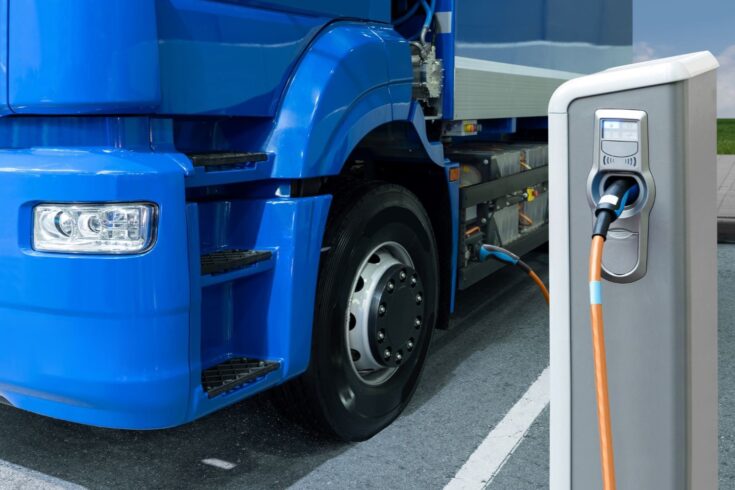Sustainable energy experts at GRIDSERVE head up a substantial consortium of industry experts to demonstrate the opportunity that can be realised by electric heavy goods vehicles (HGVs) and a viable and extensive public charging network.
The estimated 400,000 HGVs on UK roads are responsible for almost 20% of transport carbon dioxide (CO2) emissions, demonstrating exactly why a zero-emission deadline has been set for 2040 across the sector.
While a number of independent electric solutions are already making some ground in the industry, there is yet to be any consistent solution at a large enough scale to really test the potential of the opportunity.
Project Electric Freightway
Project Electric Freightway will pave the way for the wider adoption of electric-powered HGVs to replace existing diesel fleets and help resolve both environmental and efficiency issues across the sector.
Alongside the vehicles themselves, a substantial network of 350 kilowatt-capable charging points will be installed in key locations across main routes and at depots, alongside a trial of two 1 megawatt capacity chargers, all powered by net zero energy sources.
Led by principal partner Hitachi Zero Carbon, the project also aims to support this demonstration with valuable data, feedback, results monitoring and reports. These will further build the case for eHGV adoption and inform improvements, expansion and opportunities to make an electric road freight network more effective for all involved.
Video credit: Innovate UK
Video transcript and on-screen captions are available by watching on YouTube.
The project scope
The project is led by GRIDSERVE, with support from a consortium of more than 30 partners, including:
- hauliers
- charging specialists
- leasing firms
- vehicle manufacturers
- other key industry stakeholders
Within the project, more than 200 chargers will be installed across motorway services, truck stops and commercial depots, serving not only journey ends and loading points, but also across major trunk routes in the UK road network. This allows for vehicles of a range of different use cases to benefit from a more extensive infrastructure and test the potential of an electric solution.
To test this network, around 140 electric HGVs (eHGVs) will be used by consortium members across the two-year procurement and five-year testing phases. Combining involvement from small businesses to large multinationals, the project will gather a range of essential data and learnings to inform the progress towards the adoption of eHGVs more widely.
Aims and ambitions
The Electric Freightway project has lofty ambitions, looking to play a prominent role in proving the viability of an electric solution to road freight across the UK. The scale of the project, both in terms of test vehicles and charging infrastructure, is key to meeting its aim of bringing together an industry for a common cause of electrification.
By developing and operating charging hubs across service areas and around 14 different commercial depots, the project aims to facilitate the use of eHGVs in a range of scenarios. It will also allow partners to consider the future opportunity for other large vehicles, such as coaches, to make a switch to electric alternative vehicles.
With the potential saving of 18.6 million tonnes of CO2 equivalent just by replacing the UK’s HGVs, the equivalent of powering two million homes for a year, the wider benefit of including other petrol and diesel vehicles is huge.
When it comes to this need for growing industry engagement, Sam Clarke, Chief Vehicle Officer at GRIDSERVE, commented:
The key to the project is our belief in the importance of having a catalyst for transformation in the sector. It takes active demonstration of innovation to bring people on board and to show how new solutions can be brought about sooner. It’s important to see evolving change gathering speed and this project will hopefully help more and more companies and stakeholders take notice. This is not a speculative idea, the component parts of the project already exist – but it’s now time to bring everything together and all pull in one direction.
About the funding
This project is funded as part of the Zero Emission HGV and Infrastructure Demonstrator (ZEHID) programme, announced in October 2023. The projects are funded by the Department for Transport and delivered in partnership with Innovate UK, with this programme providing £200 million across four projects.
The ZEHID programme is intended to support large, five-year, on-road demonstrations of hydrogen fuel cell and battery electric zero emission HGVs, with these projects focusing on the largest HGVs. The programme will also support the government’s commitment to end sales of all new, non-zero emission HGVs by 2035 to 2040.
This project is just one example of how Innovate UK and its partners are investing to realise the vision for rail in the Transport Vision 2050 strategy document. This sets out what the UK transport system may look like in 2050, and outlines the likely steps along the way to achieving this. Innovate UK and its partners are currently investing over £500 million in transport programmes covering the pathways set out in the Transport Vision document.
Top image: Credit: Scharfsinn86, iStock, Getty Images Plus via Getty Images

